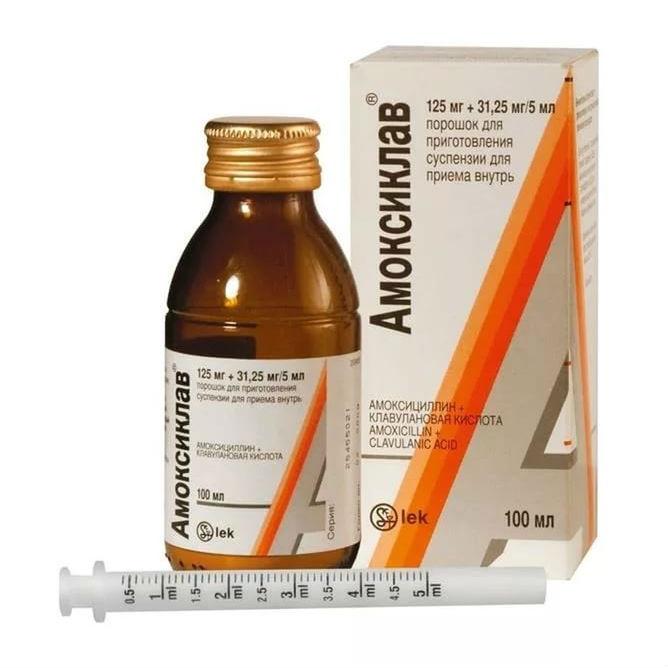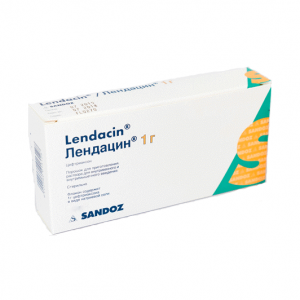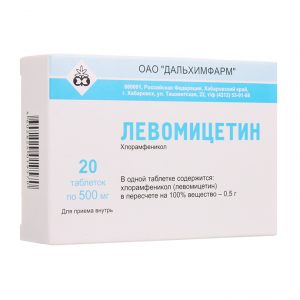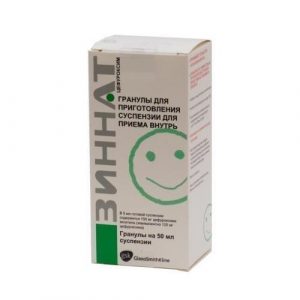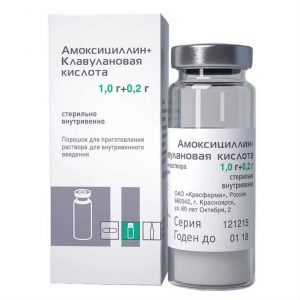Description
Release form
Powder for suspension for oral administration
Packaging
Bottle 100 ml.
Pharmacological action
Amoxiclav – a broad-spectrum antibiotic contains semisynthetic penicillin amoxicillin and a b-lactamase inhibitor clavulanic acid. Clavulanic acid inhibits most clinically significant b-lactamases (types 2, 3, 4 and 5 according to the classification of Richmond Sykes) produced by Staphylococcus spp., Escherichia coli, Proteus mirabilis, Haemophilus influenzae, Moraxella catarrhalis, Bacteroides spp. Inactive against type 1 b-lactamases produced by Enterobacter spp., Morganella morganii, Pseudomonas aeruginosa, Serratia spp., Acinetobacter spp.
This combination provides high bactericidal activity of Amoxiclav (including against strains of microorganisms resistant to amoxicillin). Clavulanic acid, having a higher affinity for b-lactamase, than amoxicillin, it forms a stable deactivated complex with the enzyme, preventing the enzymatic degradation of amoxicillin under the action of b-lactamases.
Thus, Amoxiclav acts bactericidal on a wide range of gram-positive and gram-negative bacteria (including strains that have become resistant to beta-lactam antibiotics due to the production of b-lactamases).
Amoxiclav is active against aerobic gram-positive bacteria: Streptococcus spp. (including Streptococcus pneumoniae, Streptococcus viridans, Streptococcus milleri, Streptococcus pyogenes, Streptococcus bovis), Enterococcus faecium, Staphylococcus aureus (except for methicillin-resistant strains), Staphylococcus epidermidis, spp. monocytogenes, Nocardia asteroides of aerobic gram-negative bacteria: Aeromonas spp., Bordetella pertussis, Brucella spp., Campylobacter jejuni, Campylobacter coli, Citrobacter spp. (moderately sensitive), Escherichia coli, Gardnerella vaginalis, Haemophilus ducreyi, Haemophilus influenzae, Helicobacter pylori, Klebsiella spp., Legionella pneumophila, Moraxella catarrhalis, Morganella spp. (moderately sensitive), Neisseria gonorrhoeae, Neisseria meningitidis, Pasteurella multocida, Proteus mirabilis, Proteus vulgaris, Providencia spp., Salmonella spp., Shigella spp., Vibrio cholerae, Yersinia enterocolitica (moderately susceptible) bacteria Acteria (including Bacteroides fragilis), Prevotella melaninogenica, Clostridium spp. (except Clostridium difficile), Peptostreptococcus spp., Eikenella corrodens, Fusobacterium spp., Propionibacterium spp., Treponema pallidum.
Mycobacterium tuberculosis, Mycobacterium fortuitum, Mycobacterium bovis, Mycobacterium kansasii are moderately sensitive to the drug.
Mycobacterium chelonae is resistant to the drug.
Indications
Treatment of infectious and inflammatory diseases caused by microorganisms sensitive to the drug: – infections of the upper respiratory tract and ENT organs (including acute and chronic sinusitis, acute and chronic otitis media, pharyngeal abscess, tonsillitis, pharyngitis)
– infections of the lower respiratory tract (including acute bronchitis with bacterial superinfection, chronic bronchitis, pneumonia)
– urinary tract infections
– gynecological infections
– infections of the skin and soft tissues
– infections of the bones and joints
– infections of the biliary tract (cholecystitis, cholangitis)
– odontogenic infections.
Contraindications
– cholestatic jaundice or liver dysfunction caused by the administration of amoxicillin / clavulanic acid in the history of
– hypersensitivity to amoxicillin, clavulanic acid or penicillins.
With caution, the drug should be prescribed for allergic reactions to cephalosporins and pseudomembranous colitis in the anamnesis, liver failure, severe renal impairment.
Due to the fact that in a large number of patients with infectious mononucleosis and lymphocytic leukemia who received ampicillin, the appearance of an erythematous rash was observed, the use of ampicillin antibiotics in such patients is not recommended.
Use during pregnancy and lactation
Amoxicillin and clavulanic acid pass into breast milk in small amounts.
Amoxiclav can be used during pregnancy in cases if the expected benefit to the mother outweighs the potential risk to the fetus.
Special instructions
During the course of treatment, the function of hematopoiesis, liver and kidneys should be monitored.
Patients with severe renal impairment require adequate dosage adjustment or increased dosing intervals.
In order to reduce the risk of adverse reactions from the gastrointestinal tract, the drug should be taken with meals.
When using Amoxiclav, a false-positive reaction is possible when determining the level of glucose in the urine when using Benedict’s reagent or Felling’s solution (enzymatic reactions with glucose oxidase are recommended).
Composition of
5 ml of the prepared suspension contain amoxicillin (as trihydrate) 125 mg and clavulanic acid (as potassium salt) 31.25 mg
excipients: citric acid anhydrous, sodium citrate anhydrous, sodium benzoate, microcrystalline cellulose, sodium salt carboxymethyl cellulose, xanthan gum, colloidal silicon dioxide, silicon dioxide, sodium saccharin, mannitol, flavorings.
Dosage and administration
Daily dosages of suspensions 156.25 mg / 5 ml and 312.5 mg / 5 ml (to facilitate the correct dosage in each package of suspensions 156. 25 mg / 5 ml and 312.5 mg / 5 ml are dispensed with a dosage spoon of 5 ml).
Newborns and children up to 3 months of age are prescribed 30 mg / kg (amoxicillin) / day, divided into 2 doses (every 12 hours) for children older than 3 months with moderate infections – 20 mg (amoxicillin) / kg / day, divided into 3 doses (every 8 hours),
for severe infections and respiratory infections – 40 mg / kg (amoxicillin) / day, divided into 3 doses (every 8 hours).
Recommended suspension doses (156.25 mg / 5 ml and 312.5 mg / 5 ml) are determined depending on the body weight of the child and the severity of the infection. Multiplicity of admission – 3 times / day.
Side effects of the digestive system: loss of appetite, nausea, vomiting, diarrhea rarely – abdominal pain, impaired liver function, increased liver enzymes (ALT or AST) in isolated cases – cholestatic jaundice, hepatitis, pseudomembranous colitis.
Allergic reactions: itching, urticaria, erythematous rash rarely – multiforme exudative erythema, angioedema, anaphylactic shock, allergic vasculitis in isolated cases – exfoliative dermatitis, Stevens-Johnson syndrome, acute generalized exanthematous pustulosis.
From the hemopoietic system and lymphatic system: rarely – reversible leukopenia (including neutropenia), thrombocytopenia very rarely – hemolytic anemia, reversible increase in prothrombin time (when combined with anticoagulants), eosinophilia, pancytopenia.
From the nervous system: dizziness, headache very rarely – cramps (can occur in patients with impaired renal function when taking the drug in high doses), hyperactivity, anxiety, insomnia.
From the urinary system: very rarely – interstitial nephritis, crystalluria.
Other: rarely – development of superinfection, candidiasis.
Drug interaction
With the simultaneous use of Amoxiclav and indirect anticoagulants, an increase in prothrombin time is noted. Therefore, this combination is prescribed with caution.
With the simultaneous use of Amoxiclav with allopurinol, the risk of developing side effects such as exanthema increases.
With the simultaneous use of Amoxiclav enhances the toxicity of methotrexate.
The combination of amoxicillin with rifampicin is antagonistic (there is a mutual weakening of the antibacterial effect).
Amoxiclav should not be used simultaneously with bacteriostatic antibiotics (macrolides, tetracyclines), sulfonamides due to a possible decrease in the effectiveness of Amoxiclav.
With the simultaneous use of Amoxiclav reduces the effectiveness of oral contraceptives.
overdose
There have been no reports of fatal or life-threatening side effects due to drug overdose.
Symptoms: abdominal pain, diarrhea, vomiting may also cause anxiety, insomnia, dizziness in some cases – convulsions.
Treatment: in case of recent administration of the drug (less than 4 h) it is necessary to carry out gastric lavage and appoint activated charcoal to reduce the absorption of the drug, if necessary, carry out symptomatic therapy. Hemodialysis is effective.
Storage conditions
Store in a dry, out of reach of children at a temperature not exceeding 25 ° C.
After preparation, the oral suspension should be stored at 2 ° to 8 ° C in a tightly closed vial and used for 7 days.
Shelf life
2 years.
Deystvuyushtee substance
amoxicillin, Klavulanovaya Chisloth
dosage form
oral suspension
Appointment Appointment
Children older than 3 months For children prescribed by a doctor
